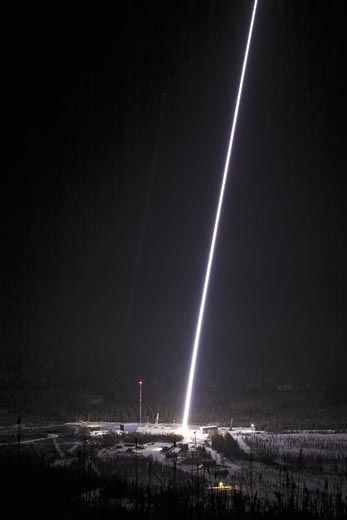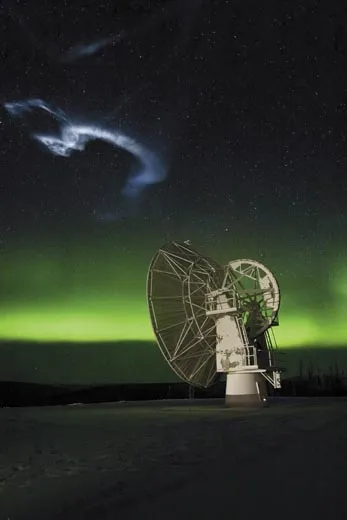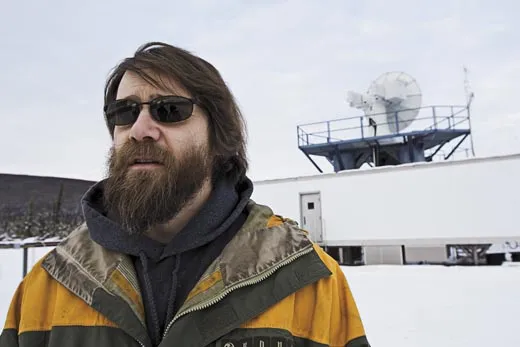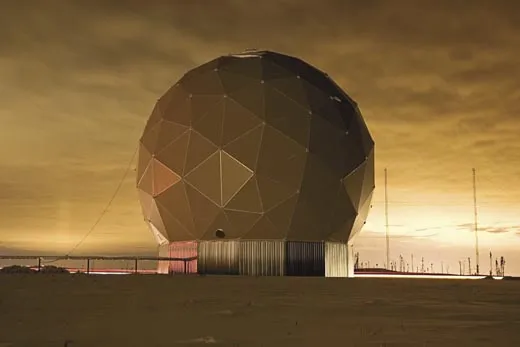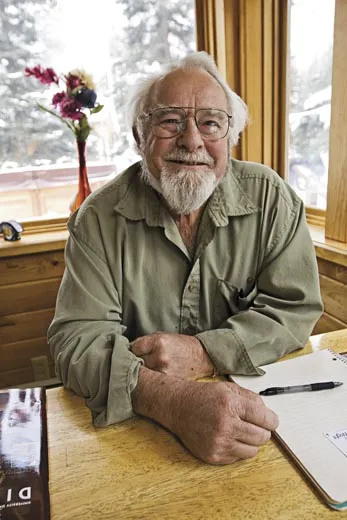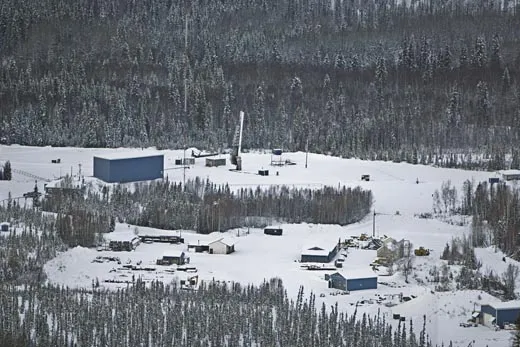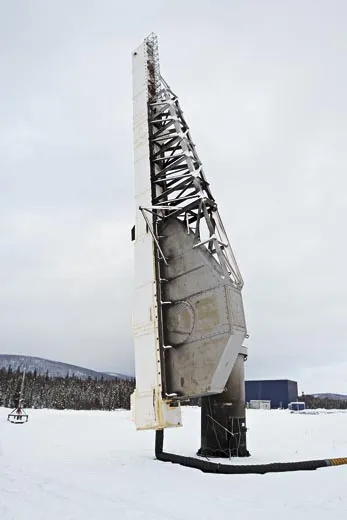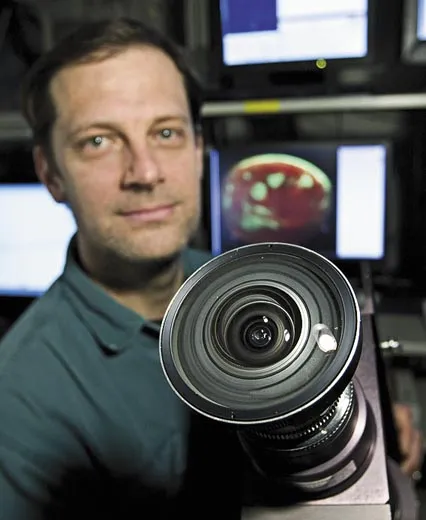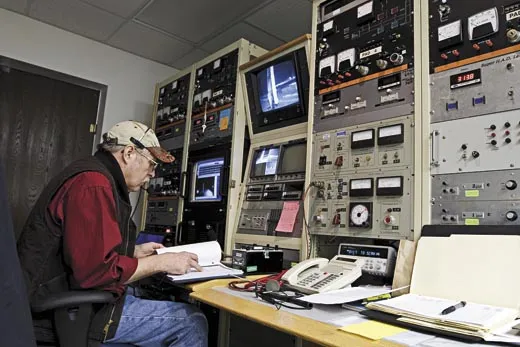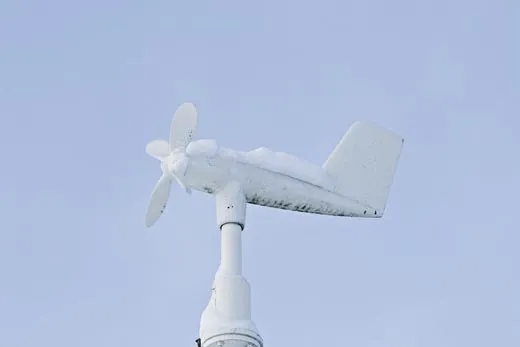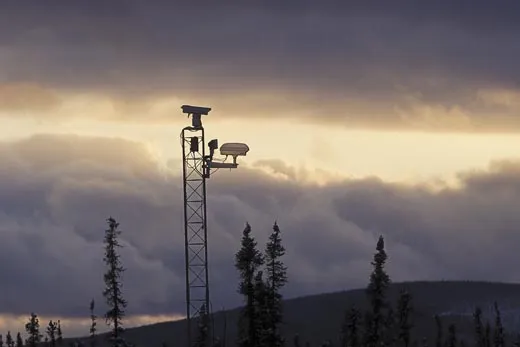The Shining
What we still have to learn about the Northern Lights.
/https://tf-cmsv2-smithsonianmag-media.s3.amazonaws.com/filer/Today_Poker_Flash_ON09.jpg)
What first appeared almost an hour ago as a strange green cloud in the northeast has now spread across most of the sky near Alaska’s Poker Flat Research Range. Sheets of green light shimmer in front of the stars, waxing and waning, as electrons from the solar wind rain down through Earth’s atmosphere, colliding with atoms and creating the aurora. Here, watching the light show under a zillion stars, I get a strong, almost physical awareness of being on a planet—a planet orbiting a star and connected to it, despite the 93 million miles of space separating them.
A loud roar breaks my reverie, and a bright point of light rapidly climbs almost straight up into the sky. A two-stage Terrier-Orion rocket is streaking into the ionosphere. Seconds later, its first stage plunges toward Earth accompanied by a high-pitched whistling sound. With a shower of sparks, the first-stage rocket motor slams into the blackness, igniting a small fire among the trees. As the last of the rocket fuel burns, the fire illuminates an otherwise invisible, snow-covered ridge. Only the NASA tracking radar has any idea where the rocket’s second stage has gone. Before the long February night is over, the temperature will drop to –21 degrees Fahrenheit and three more Terrier Mk 12 Improved Orion rockets will scream off into skies draped with the green of the Northern Lights.
Rockets from Poker Flat have been penetrating the aurora since March 1969, shortly after an international incident forced all U.S. military research programs to leave Greenland, a prime location for aurora research. In January 1968, a B-52 bomber with four thermonuclear weapons crashed near Thule Air Base; it was one of the worst nuclear incidents in the cold war. (All four bombs were destroyed and plutonium was scattered across the sea ice.) Responding to public outrage, the Danish government ejected U.S. military researchers.
The U.S. military was interested in the aurora because it had the potential to distort radar returns and because high-altitude nuclear tests in the 1950s and early ’60s had created auroras and electrical disturbances similar to those accompanying intense auroras. The Pentagon worried that its early-warning radars could be blinded or deceived. Neil Davis, a scientist at the University of Alaska Geophysical Institute who participated in military experiments in order to do basic research on the magnetosphere, explains the danger posed by auroras: If a single rocket was passing through the aurora, “all of a sudden, that single rocket looks like lots of rockets.” Intense auroras reflect radar like a piece of crumpled aluminum foil reflects the light from a flashlight. That “false positive” could have unleashed a massive retaliation.
By the time of the military projects, Davis had conducted a study on the feasibility of building a new soundings-rocket launch site 30 miles northeast of Fairbanks. That was about the time his team was disinvited to come to Greenland. The Greenland fiasco, therefore, turned out to have a silver lining for the Geophysical Institute: It was able to develop the 5,000-acre launch site with Pentagon funding. “I
didn’t expect it to last over 10 years when we started,” says Davis today.
The four Terrier-Orion rockets launched last February were part of an experiment by Gerald Lehmacher, of Clemson University in South Carolina, to model high-altitude turbulence. The rockets released chemicals that interact with atomic oxygen to form luminescent clouds, which can then be photographed over time to measure wind speeds and map wind directions. Because bright and extensive auroras heat large volumes of the upper atmosphere, they may influence global weather patterns, and the Clemson study is an attempt to understand the convection caused by the interplay of electric current and winds. It is also an example of how many different systems the aurora affects. Don Hampton, the optical science manager at Poker Flat, lists a few, besides Earth’s weather: power grids, satellite orbital mechanics, pipelines (which corrode from induced electrical current), nuclear power, and solar weather. Of course, researchers are also interested in such basic science as Earth’s electromagnetism and the behavior of plasma, or ionized gas. “Ninety-nine percent of the universe is made of plasma,” Hampton says. “It’s just important to study plasma in all its forms, and when you get to aurora altitudes, it’s pretty much nothing but plasma. We’ve made great progress in understanding auroras, but there’s still plenty to be learned.”
One of the reasons the aurora has been difficult to study is that the interactions between solar particles and the atoms and molecules in the atmosphere start at the atmosphere’s outside fringes and continue down to roughly 100,000 feet—a region of the sky too high for aircraft or most balloons but too low for satellites. (People who have seen the Northern Lights find that hard to believe, because the aurora sometimes appears low in the sky, giving the impression of being close by.) The only measurements of the aurora in the lower region have come from sounding rockets, usually surplus ground- or air-launched anti-aircraft missiles. Carrying instruments to as high as 900 miles, well above the orbits of the space shuttle and International Space Station, they have been part of an effort to understand Earth’s magnetic environment—and the sun’s impact on it—since the early 1950s.
Sitting at his kitchen table in Fairbanks, Neil Davis, now an emeritus professor, leans back and looks out a picture window, past bird feeders and falling snow. During his career, he traveled the world trying to unlock the aurora’s secrets, but the best place for rocket-borne investigations, he says, is right here at Poker Flat. “You get a lot more opportunities” to launch, he says, because the range is located just south of the aurora zone, a region surrounding the poles that sees an aurora almost every day. “And you’re shooting north,” he adds, across the aurora, which tends to run east and west, “so you can penetrate auroras. And you have this great land mass going all the way to the Arctic Ocean to do recoveries on payloads.” Logistics are easier too, says Davis. “You’ve got a railroad coming in here, a major city to support things, and military bases” to assist payload recoveries.
What scientists have learned so far is that the sun spews a constant stream of charged particles and energy: the solar wind. Most of the particles that stream past Earth are deflected by the planet’s magnetic field, and flow around it like water flowing around a rock. Some penetrate the field and are trapped in the Van Allen belts, rings of charged particles around Earth; still others spiral down the field lines at Earth’s North and South Poles. These particles, typically electrons, hurtle downward along nearly vertical lines with enormous kinetic energy. Scientists have clocked the electrons moving at 248 to 466 miles per second when they strike the magnetosphere, and at up to 36,847 miles per second as they whirl down field lines, but are unable to explain what causes the acceleration.
As the electrons descend, they repeatedly strike atoms of hydrogen, oxygen, or nitrogen, losing energy with each collision. Eventually the atmospheric atoms, which have absorbed the energy, release it as photons. Billions of escaping photons create the familiar sheet-like structures of the aurora.
While auroras occur 24 hours a day and circle both poles, their light is so dim they can be seen only at night or from spacecraft. The color of the light depends on what kind of atom was hit and how hard. The vast majority of auroras are green, but it is not uncommon to see violet or blue.
When a solar flare erupts, the hail of electrons strikes Earth’s magnetic field with enormous energy in what scientists call a magnetic storm, and the auroras redden and extend beyond the polar regions toward the equator. It must have been during such an eruption that the astronomer Galileo got his first glimpse of an aurora, observing it from Italy in 1619. He theorized that the night displays were reflections of sunlight. It was Galileo who coined the word “aurora” for the lights, Latin for “dawn.”
On March 13, 1989, a magnetic storm struck, so severe it shut down Canada’s Hydro-Québec power grid in seconds. Six million people in North America lost electricity, some of them for days, and auroras were spotted as far south as Texas. Through induced current, long metal structures, in this case Hydro-Québec’s powerlines, develop intense electrical loads. Because induced currents corrode metal, the Alaska pipeline is affected. But understanding how to protect pipelines and power grids are only two of the practical applications of knowledge about Earth’s magnetic environment. Scientists developing fusion reactors to supply power are also interested in geomagnetism.
“One of the justifications that has often been used for doing studies of the aurora is the potential application of what’s learned there on thermonuclear energy,” says Neil Davis. “The problem in developing thermonuclear energy is that you gotta contain material, very hot material” in a plasma state. Because no man-made material can tolerate the temperatures created in fusion reactions, scientists are experimenting with magnetic fields to contain and control the process.
“The aurora is a beautiful laboratory without walls,” continues Davis. “So if you can learn about those plasmas, there’s potential to apply that knowledge to the development of thermonuclear energy.”
Several nights after the Clemson launches, Brent Sadler, a graduate student from the University of New Hampshire, is waiting in a launch control blockhouse for the countdown clock to advance. For most of the night the clock has been holding at the routine mark of T-minus 10 minutes because steadily falling snow and cloud cover obscure the aurora and interfere with observations down range. If everything works as planned, the 58-foot-long, four-stage Black Brant XII, carrying a camera and five other sensors, will pass through the aurora and photograph it from above.
Kristina Lynch, professor of physics and astronomy from New Hampshire’s Dartmouth College, is the principal investigator for tonight’s project. “After the [third-stage] motor burns, we’re out of the atmosphere,” she says. “We fire the fourth motor and get as high up as we can.” That turns out to be about 370 miles, after an eight-minute flight. The five sensors, each with a GPS transmitter, will send measurements and positions to ground receivers. “There are a lot of theories about how different structures in the aurora are formed and controlled and the physics behind making a structure two meters across compared to one that is five meters across,” says Lynch. “But there’s not a lot of actual, measured data. So our hope is to have a very finely constrained data set that theorists and modelers can use to judge their theories and models.”
A crudely formed styrofoam box protects the rocket from the cold. Snaking around the massive steel gantry, a large yellow hose, connected to a roaring aircraft heater in a blockhouse 30 yards away, carries hot air into the box to keep the rocket around 70 degrees. “The rockets that we fly here all have solid fuel in them,” says Ray Martinez, who has worked at Poker Flat for almost 20 years. When it’s time to launch, it’s Ray Martinez who pushes the big red button. “If we were to let the propellant within the rocket motors get cold, it would shrink—it would pull away from the case of the rocket motor,” he explains. If a void forms, the fuel can burn through and destroy the rocket. The 70-degree goal requires attention 24 hours a day, according to New Zealander Brian Lawson, one of seven permanent employees at Poker Flat and the man responsible for keeping its computer and voice communications hardware running. “It’s not uncommon to launch at 40 below,” he says.
It seems counter-intuitive, but Sadler is worried that the camera riding atop the rocket is getting too warm. The colder the imager, the more sensitive it will be to the aurora’s light. “It’s sort of a dilemma,” says Lawson. “The rocket motors like to be warm, and the instruments like to be cold.”
Sadler is escorted from the launch control blockhouse out to the snow-covered launch pad where the rocket waits under the steady glare of floodlights. Moving as quickly as the sub-zero temperature and his bulky clothes allow, he brushes snow off a cooler outside a nearby blockhouse and reaches inside with heavily gloved hands. A man in a hurry, he dismisses my half-hearted joke about making a beer run by explaining he’s after a block of dry ice.
Ice in hand, Sadler hustles to the launcher. Opening a small hatch in its base, he climbs into a cramped space and spreads the ice over black hoses that pass through a cooler and up to chill an aluminum block supporting the digital camera.
For the dozens of folks who work on a soundings rocket project, a 30-minute break in the weather can be all it takes to end weeks of tension and boredom. The principal investigators, sitting with their computers on top of a nearby mountain, are under intense pressure to decide whether conditions at Poker Flat are good enough to launch. High-altitude winds, passing clouds, weak auroras, or bad weather at remote observation sites downrange can scuttle a launch. With years of work and as much as several million dollars riding on their decisions, the nightmare for the principal investigators comes when conditions are marginal. That’s when science becomes a high-stakes poker game.
Tonight, the weather wins the hand. At 1 a.m., the launch is scrubbed. Almost five weeks later, the Black Brant carried the camera and five sensors into a vibrant aurora. Lynch’s team is now analyzing the data and expects to make the next incremental contribution to the body of knowledge collected by the rockets launched from Poker Flat.
Tim Wright is a writer and photographer living in Richmond, Virginia.
